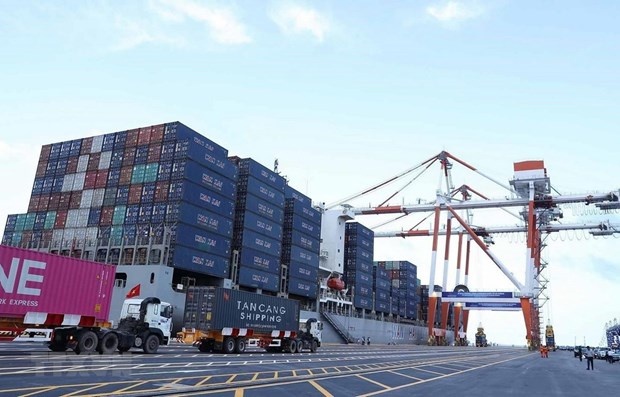Long-term focus crucial in face of quarterly GDP drop
 |
| Illustrative image. Photo: VNA |
The processing and manufacturing industry is no longer considered a growth driver for the fourth quarter, and the GDP of the third quarter was estimated to have dropped by 6.17 per cent compared to the same period last year – the worst dip since Vietnam began calculating quarterly GDP in 2000.
Le Trung Hieu, director of the Department of the National Accounts System under the General Statistics Office (GSO) said, “Industrial values of Ho Chi Minh City, Binh Duong, Dong Nai, and Ba Ria-Vung Tau were heavily affected, which had a significant impact on the country’s GDP growth.”
According to Hieu, the low growth of the fisheries sector in the third quarter has impacted and reduced industrial growth. Prolonged social distancing affected harvests, production, and processing of aquatic products in the Mekong Delta.
Basa fish production in this area accounts for almost all national production, while shrimp from this area cover around 80 per cent of the country’s total shrimp output. In the Mekong Delta, 120 of 449 seafood factories stopped working due to social distancing, and those remaining worked at just 30-40 per cent of total capacity.
Industrial production remains an important driving force of Vietnam’s economy, but was severely affected. Manufacturers have been struggling to cope with rising commodity prices, the impact of the pandemic, and shortages of raw materials.
The inventory index of the entire manufacturing industry estimated as of September 30 increased 3.5 per cent over the same period last month and 28.2 per cent over the same period last year, according to data from the GSO.
The Asian Development Bank in Vietnam has continuously lowered its growth forecast for Vietnam, from 6.7 per cent in April to 5.8 per cent in July and 3.8 per cent in September.
With a low growth rate during the last nine months, the 6-per-cent target set by the National Assembly, as well as the government’s 6.5-per-cent plan, will be near-impossible to reach as the number of businesses suspending operations at least temporarily increased by 16.7 per cent, while other enterprises stopped operating entirely and have been waiting for their dissolution, up 17.4 per cent.
Nguyen Thi Huong, director general of the GSO, said growth can be supported by public investment, exports, and increased consumption. According to Huong, well implemented measures to transform the anti-pandemic model and speed up the reopening of the economy – especially major economic centres such as Hanoi and Ho Chi Minh City – would be necessary to recover the economy in the fourth quarter.
However, Vietnam’s imports and exports have also been slowing down, decreasing 2 per cent in September compared to August. The 19 southern provinces, equivalent to 45 per cent of Vietnam’s export turnover, were affected by the prolonged social distancing during that time.
Meanwhile, the production capacity of the northern provinces of Bac Ninh and Bac Giang has not yet recovered, while bordering countries have not yet restored customs clearances. Now, Lao Cai customs is worried that exports will have difficulties which then could affect the budget revenue plan.
For example, the main export product through the border gates of the northern province of Lao Cai, dragon fruit, has not yet been cleared for customs by the Chinese side. By the end of August, Lao Cai’s total import and export tax revenues only reached around 56 per cent of the original target assigned by the Ministry of Finance.
Nevertheless, experts believe that a GDP growth rate of 3.5-4 per cent is still achievable. Vietnam’s economy could recover if the pandemic is controlled by the end of 2021, or at the latest by the end of the second quarter of 2022, and if 70 per cent of the country’s population are fully vaccinated.
Tran Thanh Hai, deputy director of the Foreign Trade Agency under the Ministry of Industry and Trade, said that the growth rate of export turnover reached a considerable 18.8 per cent after nine months. In 2020, the country’s export turnover only increased by about 7 per cent.
“I hope that in the last three months of the year, the southern localities will regain their growth momentum and balance out their economies,” Hai said.
Nguyen Thi Hong Minh, director of the Central Institute for Economic Management, said that over the next six months or so, the government should prioritise pandemic prevention, combined with suitable macro policies and the promotion of disbursements of public investment to support businesses through these tough times.
By late 2023, macroeconomic policies could be loosened in the country, stimulating the economy and creating more resilience for businesses, Minh added.
After that point, Vietnam aims to continue to normalise macroeconomic policies and promote far-reaching economic reforms. “The government also needs to accelerate support packages for the people and immediately remove difficulties for them in accessing support,” Minh said.
What the stars mean:
★ Poor ★ ★ Promising ★★★ Good ★★★★ Very good ★★★★★ Exceptional
 Tag:
Tag:
Related Contents
Latest News
More News
- Businesses ramp up production as year-end orders surge (December 30, 2025 | 10:05)
- Vietjet chairwoman awarded Labour Hero title (December 29, 2025 | 13:06)
- How to unlock ESG value through green innovation (December 29, 2025 | 10:03)
- AI reshapes media and advertising industry (December 29, 2025 | 08:33)
- FPT and GELEX sign deal to develop blockchain tech for global markets (December 29, 2025 | 08:29)
- Vietnam’s GDP forecast to grow by 9 per cent in 2026 (December 29, 2025 | 08:29)
- Women entrepreneurs are key to Vietnam’s economic growth (December 29, 2025 | 08:00)
- Vietnam's top 500 value-creating enterprises announced (December 27, 2025 | 08:00)
- The PAN Group shaping a better future with ESG strategy (December 26, 2025 | 09:00)
- Masan Consumer officially lists on HSX, marking the next phase of value creation (December 25, 2025 | 13:20)























 Mobile Version
Mobile Version